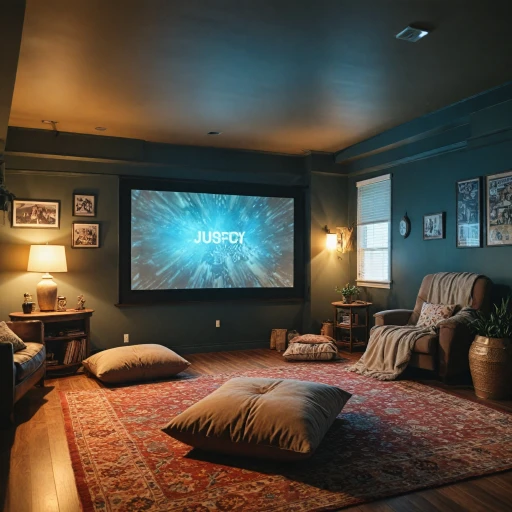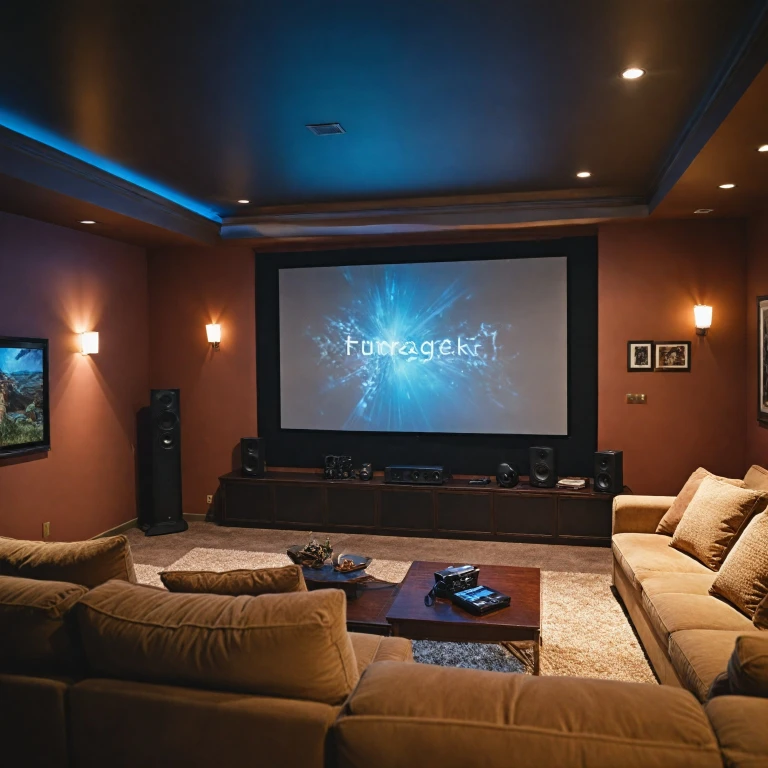Understanding Projector Mount Types
Different Types of Projector Mounts: A Quick Overview
Deciding on the right mount for your home theater projector can significantly enhance your cinematic experience. Here’s a breakdown of the types of projector mounts available, each catered to different needs and settings:
- Ceiling Mounts: These are perfect for those wanting to save on floor space and keep the projector out of the way. They work well with projectors that have lens shift capabilities and can be the ideal choice if you're aiming for a clean, professional look in your home theater. Additionally, ceiling plates and monitor arms can be critical accessories to ensure sturdiness and flexibility.
- Wall Mounts: Opt for a wall mount if you have limited ceiling height or if you prefer having the projector closer to the screen. Wall mounts are great for short throw projectors and can be easily adjusted for optimal screen coverage.
- Furniture Mounts: While not as common, these solutions incorporate your projector into existing furniture designs, providing a seamless integration into your living space. They're ideal for anyone who values aesthetics and functionality equally.
- Rack Mounts: These are typically used in setups that include more extensive audio-visual setups. Rack mounts are accompanied by necessary accessories like racks and rack accessories, providing efficient storage and cable management. They often accompany professional setups in larger rooms rather than home environments.
Understanding these types can guide you in optimizing your projector’s position for the best viewing experience. For those interested in further enhancing their setup, exploring options such as
enhancing your viewing experience with a recessed TV mount could offer additional insights into integrating your projector smoothly into your home theater space.
Key Features of a Quality Projector Mount
Essential Features for Picking a Mount
When it comes to selecting the right mount for your home theater projector, understanding the key features of a quality projector mount can make a significant difference. A well-chosen mount not only secures your projector but also enhances your viewing experience by providing stability and flexibility. Here are some critical elements to consider:
- Adjustability and Flexibility: Opt for mounts that offer a wide range of movement options. These might include tilt, swivel, extension, and rotation capabilities to accommodate different viewing angles and screen surfaces. This flexibility ensures that you can achieve the perfect viewing angle with ease.
- Sturdiness and Durability: The mount should be sturdy enough to support the weight of your projector without sagging. Look for mounts constructed from high-quality materials, such as steel or aluminum, which provide the necessary strength and longevity.
- Compatibility: Ensure that the mount is compatible with your specific projector model. Check the VESA standards and the mounting holes on your projector to match them with the mount's configuration. Compatibility with other furniture accessories like racks can also be beneficial.
- Cable Management: A quality mount often features integrated cable management systems. These facilitate clean installation by hiding the cables from sight, thus maintaining a neat and professional appearance.
- Installation Ease: Be sure to consider how easy it is to install the mount. Some mounts may require additional accessories or tools for setup, while others include convenient features like quick-release mechanisms or adjustable arms.
- Safety Features: Safety should never be compromised. Look for mounts that come with effective locking mechanisms to prevent the projector from slipping or falling. This is particularly important for ceiling mounts and projector mounts placed on higher walls.
Consider choosing a mount that integrates well with your existing audio or video equipment. For example, some mounts can be used alongside ceiling plates and monitor arms to enhance functionality. Utilizing mounts created by reputable manufacturers like Chief can also guarantee quality and dependability. If interested, you can explore their unique products, including the
Chief offset fixed ceiling plate for tailored recommendations. Making an informed choice on these key features will ensure a seamless and enjoyable viewing experience with your projector system.
Installation Considerations for Projector Mounts
Important Aspects to Consider During Installation
When you're set to install a projector mount, whether it's a ceiling mount or wall mount, there are several critical factors that can impact the overall experience and safety. With numerous products on the market, such as mounts from Chief and Middle Atlantic, it's essential to understand installation considerations to ensure seamless integration with your home theater setup.
- Load Capacity: Each mount comes with a specific load capacity. Verify that the mount can support the projector's weight by checking product specifications carefully. This will help prevent any accidents or damage to both the mount and the projector.
- Stud Finder and Ceiling Plate: Utilizing a stud finder ensures that the wall or ceiling attachment points are secure, reducing the risk of mounts coming loose. Use a durable ceiling plate for ceiling mounts to provide additional support.
- Power Source Accessibility: During installation, remember to plan for a convenient power source. Ensure your projector mount location has easy access to a power outlet or consider installing new outlets if necessary.
- Video Signal and Connection: Assess the path for your video and audio cables. Avoid straining cables as they can affect performance. Conceal cables using furniture accessories if possible, or consider using integrated cable management systems in some projector mounts.
- Screen Alignment: For optimal viewing experience, align your projector with the center of the projection screen surface. Incorrect alignment can lead to image distortion and negatively affect the view quality. Short throw projectors need particular attention to avoid oversized display issues.
By keeping these installation considerations in focus, you can pave the way for a smooth setup process that optimizes quality and safety. For more information on renting projectors and screens to test your configuration before making a purchase, check this
relevant resource.
Implementing these insights aids in creating a reliable and professional-looking home theater environment.
Optimizing Viewing Experience with Proper Mount Placement
Enhancing Visual Experience with Optimal Mount Positioning
Optimizing the viewing experience with proper mount placement is essential for any home theater setup. A well-placed projector mount not only enhances picture quality but also creates an immersive viewing environment that rivals commercial cinemas.
When determining the ideal placement for your projector mount, consider these factors:
- Screen Size and Aspect Ratio: The size and aspect ratio of your projector screen will dictate how far back the projector needs to be positioned. Always assess the manufacturer's throw distance specifications for the projector you use to ensure it covers the entire screen surface without distortion.
- Ceiling vs Wall Mounts: Ceiling mounts are typically recommended for most home theater setups, as they allow greater flexibility in adjusting the projector height and angle. However, if aesthetics or room constraints make a ceiling mount impractical, wall mounts provide a viable alternative. Assess ceiling plate and wall rack accessories for optimal integration into your space.
- Room Layout and Furniture: Consider the arrangement of furniture, accessories, and possible obstructions that might interfere with the projected image. A ceiling-mounted projector avoids potential obstacles like furniture pieces or foot traffic, ensuring an unobstructed view.
- Projector Orientation: For short throw and ultra short throw projectors, wall mounts near the screen are often preferable, reducing the throw distance dramatically. This minimizes shadowing and maximizes brightness on the screen surface.
Achieving the perfect alignment and distance for your projector mount can significantly affect the quality of your home theater. Ensure it’s secure yet adjustable enough to fine-tune to the best angle.
- Ambient Light Control: Minimize light from windows or lamps that may wash out the display. Black-out curtains or window shades can help manage this issue effectively.
Lastly, consider investing in power surge protectors and appropriate storage solutions like middle atlantic rack accessories for your projector and other electronics. This not only ensures your equipment remains safe during operation but also extends its lifespan.
Explore different monitor arms and speaker mounts to complete your setup, creating an all-encompassing audio-video experience that transports you into your favorite films and shows. Customer reviews can offer valuable insights into the effectiveness of various mounts projector options and might guide your purchasing decision.
Maintenance and Safety Tips for Projector Mounts
Routine Checks and Ensuring Safety
Proper maintenance and safety measures are crucial for ensuring the longevity and performance of your projector mount setup. Here are some guidelines to help keep your installation secured and operational:
- Regular Inspections: Consistently check your ceiling or wall mount for any signs of wear, loosened screws, or corrosion. Ceiling mounts and wall installations especially, require periodic inspections due to their constant exposure to environmental factors.
- Cable Management: Safeguard the cables connecting your projector to the power source, home theater screen, and speakers. Well-managed cables prevent tripping hazards and avoid undue strain, increasing the longevity of your setup.
- Weight Distribution: It's vital that the weight of the projector is well-supported by the mount. Always adhere to the mount product's weight specification and ensure it's suited for the surface it's attached to, be it a ceiling or a wall.
- Adjustments and Realignments: Over time, vibrations or accidental nudges can misalign the projector from its optimal position. Make necessary adjustments to align the project with your screen surface to maintain the best view and video display quality.
- Environment Control: Protect your projector and mount from excessive heat and humidity. Consider proper ventilation and a controlled room environment to prevent thermal damage.
- Secure Plug Connections: Make sure all power and signal connections are secure. This is particularly critical if you use additional accessories, like speaker mounts or monitor arms, which could cause additional strain on the setup.
- Expert Maintenance: For complex installations, or if your setup seems unstable, consider reaching out to a professional. Engaging experts can be especially beneficial for intricate configurations, such as a middle atlantic video wall or setups with short throw projectors.
Regular maintenance combined with the right furniture accessories and storage solutions ensures that your home theater investment remains protected and efficient over time. Being proactive about these safety measures guarantees a worry-free viewing experience.
Top Recommendations for Chief Projector Mounts
Top Choices for Chief Projector Mounts
When setting up your home theater system, selecting the right projector mount is crucial for optimizing performance and ensuring your equipment is secure. Chief projector mounts are highly regarded in the industry for their quality and versatility. Here are some of the top recommendations for Chief mounts to consider:
- Chief CMA Adjustable Extension Column: Perfect for ceiling installations, this extension column provides adjustable height settings, accommodating various ceiling heights to ensure the ideal screen surface alignment. Adding middle atlantic accessories can further customize this setup to fit unique room dimensions.
- Chief CMS-440 Adjustable Suspended Ceiling Kit: This system is excellent for rooms with suspended ceilings. It's designed for easy integration and provides a clean look that blends well with most decor. Pair it with the Chief CMA ceiling plate for added stability.
- Chief RPM Elite Universal Mount: Known for its flexibility, this ceiling mount accommodates a wide range of projector models. With quick adjustments and easy installation, it's a favorable choice for those who frequently update their equipment.
- Chief RPA Elite Projector Mount: This is ideal for users who prioritize quick and easy maintenance. It features independent roll, pitch, and yaw adjustments, and its tool-less capabilities make it a hassle-free option when it's time for maintenance or upgrades.
Investing in one of these top-tier Chief projector mounts can ensure your home theater setup remains secure and provides optimal viewing enjoyment. Remember to assess the compatibility of your mount with any additional furniture accessories and storage solutions to maintain the overall aesthetic and functionality of your space. Taking time to select the appropriate mounting setup can greatly enhance the quality and enjoyment of your home theater experience.

